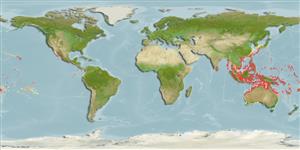Preferred temperature (Ref.
123201): 25.4 - 29, mean 28.1 °C (based on 950 cells).
Phylogenetic diversity index (Ref.
82804): PD
50 = 0.5020 [Uniqueness, from 0.5 = low to 2.0 = high].
Bayesian length-weight: a=0.01698 (0.00895 - 0.03223), b=3.01 (2.84 - 3.18), in cm total length, based on LWR estimates for this species & (Sub)family-body (Ref.
93245).
Trophic level (Ref.
69278): 3.8 ±0.7 se; based on size and trophs of closest relatives
Resilience (Ref.
120179): Medium, minimum population doubling time 1.4 - 4.4 years (Preliminary K or Fecundity.).
Fishing Vulnerability (Ref.
59153): Low vulnerability (14 of 100).
Nutrients (Ref.
124155): Calcium = 66.8 [24.0, 150.8] mg/100g; Iron = 0.781 [0.285, 1.778] mg/100g; Protein = 18.6 [15.8, 20.8] %; Omega3 = 0.148 [0.076, 0.291] g/100g; Selenium = 28.7 [9.9, 84.8] μg/100g; VitaminA = 127 [40, 458] μg/100g; Zinc = 1.95 [0.85, 3.39] mg/100g (wet weight);
